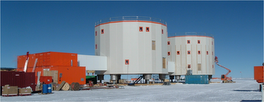Sunday seismometer #2
Reuber-Ehlert (1895)
In 1895 Reinhold Ehlert - continuing the work of Reuber-Paschwitz whose instrument provided the first recording of a distant earthquake (see Sunday siesmometer #1) - modified the original Reuber-Paschwitz design to come up with a new instrument.

The Reuber-Ehlert seismometer has not one but three undamped horizontal pendulums weighing 200g each, and has a natural period of 12 seconds.

A mirror is attached to each pendulum, and reflects a light beam back out through the windows at the front of the instrument. The reflected light can then be recorded on a roll of photographic paper. The amplification depends directly on the distance between the mirror and the recording apparatus.

The use of three horizontal pendulums to record two orthogonal directions of motion may seem curious to us today, as does the lack of damping in both this and the original Reuber-Paschwitz seismometer.
The Reuber-Ehlert seismometer was installed at the Astronomical Observatory in Strasbourg in 1895, then moved to the newly built Seismological Observatory in 1900, where it was kept running until 1906.




No comments:
Post a Comment